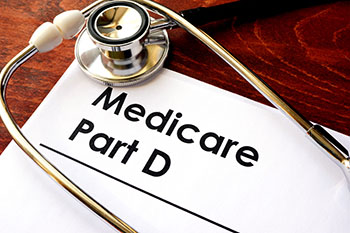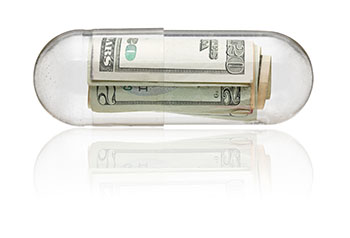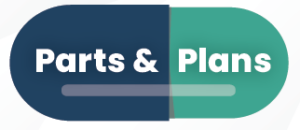Medicare Prescription Drug Plan – Part D
![]() The Medicare federal health care program for Americans age 65 and up (and people under 65 with certain medical conditions), offers a Prescription Drug Plan (PDP) as an optional benefit. Known as Part D in the Medicare alphabet, you can add a PDP to Original Medicare Part A, Hospital Coverage and Part B, Medical Coverage. You may also get this coverage by choosing a Medicare Advantage (Part C) plan, as many of them include prescription drug coverage.
The Medicare federal health care program for Americans age 65 and up (and people under 65 with certain medical conditions), offers a Prescription Drug Plan (PDP) as an optional benefit. Known as Part D in the Medicare alphabet, you can add a PDP to Original Medicare Part A, Hospital Coverage and Part B, Medical Coverage. You may also get this coverage by choosing a Medicare Advantage (Part C) plan, as many of them include prescription drug coverage.
 Why Medicare Part D?
Why Medicare Part D?
According to the Kaiser Family Foundation, prescription drugs are a part of the care plan for 59 million seniors and people with disabilities. What’s more, the drugs account for $1 of every $6 in Medicare spending.
Private companies offer Part D plans in accordance with Medicare guidelines.
Most Medicare Plan D members pay a monthly premium, which varies by provider. To participate in a Part D plan, you must live in the plan service area. Whether you select a stand-alone Part D plan or go with a Medicare Advantage plan, you must have Part A and/or Part B in order to join.
Why Medicare Part D?
According to the Kaiser Family Foundation, prescription drugs are a part of the care plan for 59 million seniors and people with disabilities. What’s more, the drugs account for $1 of every $6 in Medicare spending.

Private companies offer Part D plans in accordance with Medicare guidelines.
Most Medicare Plan D members pay a monthly premium, which varies by provider. To participate in a Part D plan, you must live in the plan service area. Whether you select a stand-alone Part D plan or go with a Medicare Advantage plan, you must have Part A and/or Part B in order to join.
How Medicare Part D works
AmeriLife suggests you select a PDP when you are eligible, even if you do not currently take any prescription medications. There are two reasons:
- If you fail to sign up for Medicare prescription drug coverage when you first become eligible, unless you have what Medicare considers creditable drug coverage, such as through an employer or union, you could end up paying more not only to get Part D, but also to keep it; and
- You never know when you may need a PDP and its cost savings.
Keep in mind, however, that if you leave an employer or union plan with drug benefits to join a Medicare PDP, you may not be able to return to your previous plan.
Common Medicare Part D terms
 Formulary – a list of medications covered by a prescription drug plan. It usually includes tiers, or levels, of coverage based on how much the drugs cost. In general, the higher the drug price, the more the plan member must contribute to its purchase.
Formulary – a list of medications covered by a prescription drug plan. It usually includes tiers, or levels, of coverage based on how much the drugs cost. In general, the higher the drug price, the more the plan member must contribute to its purchase.
Deductible – Members pay this amount before the PDP starts meeting the costs of covered medications. Not all PDPs have a deductible. For those that do, once the deductible is met, members must contribute plan-specified amounts in the form of copayments or coinsurance for their medications.
Copay – a pre-determined dollar amount you pay as your portion of the cost of a medication. While coinsurance is also an amount you pay as your share of services once a deductible has been met, it is most often a percentage, say 30%.
Late penalty – This normally applies if you fail to sign up for a PDP within three months of becoming eligible for Medicare Part A or Part B and you don’t have creditable coverage such as through an employer, a union, or the U.S. Department of Veterans Affairs (VA). Medicare calculates the penalty by multiplying the percentage of the national base beneficiary premium and the number of months you delayed signing up. This can add up over time.
 Formulary – a list of medications covered by a prescription drug plan. It usually includes tiers, or levels, of coverage based on how much the drugs cost. In general, the higher the drug price, the more the plan member must contribute to its purchase.
Formulary – a list of medications covered by a prescription drug plan. It usually includes tiers, or levels, of coverage based on how much the drugs cost. In general, the higher the drug price, the more the plan member must contribute to its purchase.
Deductible – Members pay this amount before the PDP starts meeting the costs of covered medications. Not all PDPs have a deductible. For those that do, once the deductible is met, members must contribute plan-specified amounts in the form of copayments or coinsurance for their medications.
Copay – a pre-determined dollar amount you pay as your portion of the cost of a medication. While coinsurance is also an amount you pay as your share of services once a deductible has been met, it is most often a percentage, say 30%.
Late penalty – This normally applies if you fail to sign up for a PDP within three months of becoming eligible for Medicare Part A or Part B and you don’t have creditable coverage such as through an employer, a union, or the U.S. Department of Veterans Affairs (VA). Medicare calculates the penalty by multiplying the percentage of the national base beneficiary premium and the number of months you delayed signing up. This can add up over time.
Medicare Part D Coverage Gap (Donut Hole)
 This term refers to the gap in coverage by prescription drug plans that occurs when the member and the plan have each contributed a set amount outlined in the plan for the medications that it covers. Some people will not experience the gap because the costs of their medications will not reach that level.
This term refers to the gap in coverage by prescription drug plans that occurs when the member and the plan have each contributed a set amount outlined in the plan for the medications that it covers. Some people will not experience the gap because the costs of their medications will not reach that level.
According to the Medicare & You 2018 guidebook, people who enter the donut hole this year pay 35% of the covered brand-name drug costs outlined in the plan; and 44% of the plan cost for generic drugs. This continues until the person reaches the end of the gap.
Your annual deductibles, coinsurance and copayments all contribute toward removing the coverage gap. So do discounts you receive on covered brand-name drugs in the gap and what you pay in the gap. However, the plan premium does NOT count toward getting you out of the gap, nor does what you pay for drugs not covered under your plan.
Catastrophic coverage – Part D plan members automatically receive this once they are out of the donut hole. Their coinsurance and copayments are reduced for covered drugs during the remaining plan year.
People who qualify for Extra Help (or the Low Income Subsidy) will avoid the coverage gap or donut hole. Extra Help is a federal program helping eligible individuals with limited income pay for Medicare Part D costs such as premiums, deductibles and copayments/coinsurance.
You may apply for this program through your state’s Medicaid department or the Social Security Administration. Learn more
 This term refers to the gap in coverage by prescription drug plans that occurs when the member and the plan have each contributed a set amount outlined in the plan for the medications that it covers. Some people will not experience the gap because the costs of their medications will not reach that level.
This term refers to the gap in coverage by prescription drug plans that occurs when the member and the plan have each contributed a set amount outlined in the plan for the medications that it covers. Some people will not experience the gap because the costs of their medications will not reach that level.
According to the Medicare & You 2018 guidebook, people who enter the donut hole this year pay 35% of the covered brand-name drug costs outlined in the plan; and 44% of the plan cost for generic drugs. This continues until the person reaches the end of the gap.
Your annual deductibles, coinsurance and copayments all contribute toward removing the coverage gap. So do discounts you receive on covered brand-name drugs in the gap and what you pay in the gap. However, the plan premium does NOT count toward getting you out of the gap, nor does what you pay for drugs not covered under your plan.
Catastrophic coverage – Part D plan members automatically receive this once they are out of the donut hole. Their coinsurance and copayments are reduced for covered drugs during the remaining plan year.
People who qualify for Extra Help (or the Low Income Subsidy) will avoid the coverage gap or donut hole. Extra Help is a federal program helping eligible individuals with limited income pay for Medicare Part D costs such as premiums, deductibles and copayments/coinsurance.
You may apply for this program through your state’s Medicaid department or the Social Security Administration. Learn more
Changing your plan
The Medicare Annual Enrollment Period – always Oct.15 through Dec. 7 – is the first window of opportunity to switch your Prescription Drug Plan. The new plan will go into effect Jan. 1 of the following year.
Lastly, depending on the circumstances, you may be able to switch your Part D coverage during a special enrollment period or SEP. Learn more
We know Medicare Part D
With nearly a half-century in the senior market, AmeriLife is very familiar with the federal Medicare program, including Part D prescription drug plans.
Think of it as a puzzle with many pieces. You could do it alone, but it’s easier with help.
The company’s insurance representatives must become certified to offer Medicare products to consumers in their respective states; and undergo re-certification every year.
An agent would be glad to sit down with you to review your options and answer your questions.
Connect with an Agent
A licensed sales representative may contact you to listen to your needs.

